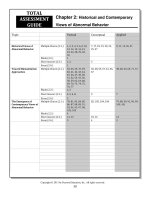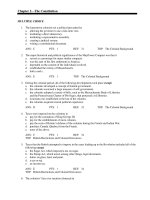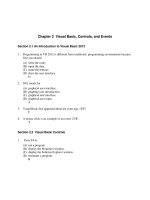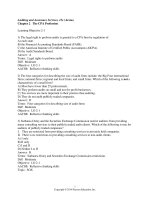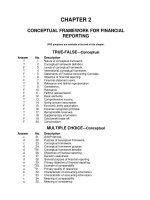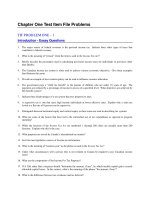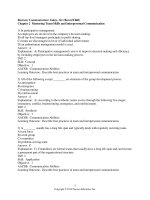Texas politics today 2011 2012 edition 15th edition maxwell test bank
Bạn đang xem bản rút gọn của tài liệu. Xem và tải ngay bản đầy đủ của tài liệu tại đây (154.64 KB, 9 trang )
CHAPTER 2 THE TEXAS CONSTITUTION IN PERSPECTIVE
MULTIPLE CHOICE
1. Government is a process of decision making conditioned by all of the following except
a. the people.
c. interest groups.
b. history and political parties.
d. bureaucracy.
ANS: D
REF: 41
2. Constitutions are expected to do all of the following except
a. assign constitutional power.
c. place limitations on the government.
b. identify political leaders.
d. establish major governing institutions.
ANS: B
REF: 42
3. A constitution promotes __________ if the general public agrees that the government has the right to
govern its citizens.
a. social contract
c. legitimacy
b. treatise
d. legality
ANS: C
REF: 42
4. In their struggle for power, which institution has acted as an umpire between the national and state
governments?
a. The United States Congress
c. The United States Supreme Court.
b. The President of the United States
d. Federal bureaucracies
ANS: C
REF: 42
5. Under Article 1, the U.S. Constitution gives the national government all of the following expressed
powers except
a. conduct foreign policy.
c. raise and support an army.
b. regulate intrastate commerce.
d. borrow money.
ANS: B
REF: 42
6. Powers of the national government stated in the United States Constitution are called
a. concurrent.
c. delegated.
b. reserved.
d. committed.
ANS: C
REF: 42
7. The implied powers of the national government are designed to do whatever is necessary to
a. carry out the expressed powers of the national government.
b. carry out the expressed powers of the national and state governments.
c. establish the inherent powers of the national government.
d. establish the reserved powers of the states.
ANS: A
REF: 42
8. Which is a true statement about the powers of the national government?
a. The only powers of the national government are those specifically stated.
b. How much power the national government has depends on the interpretation of the
“necessary and proper clause.”
c. Powers are determined by the supremacy clause.
d. Powers of the national government are equal to the powers of the state governments.
ANS: B
REF: 42
9. Which of the following is not a provision of the federal Patient Protection and Affordability Care Act
of 2010 (Health Care Reform)?
a. An individual mandate that requires uninsured individuals to buy health or pay a fine.
b. Provides for state exchanges through which individuals and small businesses may
purchase insurance.
c. Those without employer-based health insurance may be eligible for federal subsidies.
d. The Medicaid program will be reduced due to a reduce need.
ANS: D
REF: 43
10. Powers assigned to both the national and state governments are called
a. reserved.
c. special.
b. concurrent.
d. federal.
ANS: B
REF: 44
11. Reserved powers are those that belong
a. to the national government.
b. to the state governments.
c. to the national and state governments.
d. to the local governments only.
ANS: B
REF: 44
12. Which is a correct statement about the Tenth Amendment?
a. The federal courts have frequently used this amendment to invalidate national government
actions.
b. In spite of this amendment the U.S. Supreme Court in McCulloch v. Maryland permitted
federal action through implied powers.
c. The federal courts used this amendment to allow the national government to commandeer
state agencies to the service of the federal government.
d. It stated that all powers not explicitly delegated to the national government are reserved to
the states exclusively.
ANS: B
REF: 44
13. Which U.S. Constitutional Amendment has been used by the U.S. Supreme Court to extend most of
the provisions in the Bill of Rights to state governments?
a. Sixteenth Amendment
c. Fourteenth Amendment
b. Fifteenth Amendment
d. Thirteenth Amendment
ANS: C
REF: 45
14. Which of the following is correct about the secessionist movement in Texas?
a. Over 50% of Texans believe the state has the right to secede.
b. Over 50% of Texans believe that the state would be better off as an independent country.
c. Texas has no legal right to secede from the Union.
d. Texas can only secede if state voters approved the proposition
ANS: C
REF: 46
15. The Twenty-fourth Amendment to the U.S. Constitution forbids states from which of the following?
a. Using age in setting voting requirements.
b. Prohibiting persons from voting on the basis of gender.
c. Allowing the appointment of U.S. senators.
d. Enacting poll tax laws as a condition for voting in a national election.
ANS: D
REF: 45
16. Which is not a correct statement about the present-day Texas Constitution?
a. It is one of the most restrictive.
b. It has been amended 467 times as of 2010.
c. It is the longest state constitution.
d. It is the fourth most frequently amended state constitution.
ANS: C
REF: 46
17. Which of the following concerning the Texas Constitution of 1836 is not correct?
a. It called for a careful separation of Church and State.
b. It legalized slavery in Texas.
c. It prohibited the president from serving consecutive terms.
d. It established a federal system of government for the Republic.
ANS: D
REF: 47
18. Texas fought and won its independence from which of the following countries?
a. Spain
c. Mexico
b. Great Britain
d. United States
ANS: C
REF: 47
19. A unitary system of government means there is
a. a single legislative branch.
b. a single court system.
c. a central government with primary constitutional authority.
d. only one branch at the national level.
ANS: C
REF: 47
20. Which of the following is not true of the Texas Constitution of 1845?
a. It was similar to other southern state constitutions of the time.
b. It exempted homesteads from foreclosure.
c. It provided for community property.
d. It granted the governor a term of four years.
ANS: D
REF: 47
21. Which is a correct statement about the Texas Constitution of 1866?
a. Secession from the union was nullified.
b. Confederate war debts were renounced.
c. A civilian government was established.
d. all of these
ANS: D
REF: 47
22. Which of the following is not correct about the Texas Constitution of 1869?
a. It centralized state power in the hands of the governor.
b. It provided for annual legislative sessions.
c. It decentralized the Texas public school system.
d. It allowed the governor to appoint all major state offices.
ANS: C
REF: 47
23. Which of the following was the slogan of the Texas Grange going into the 1875 Constitutional
Convention??
a. “Retrenchment and reform”
c. “Reconstruction or die”
b. “Onward to the Future”
d. “Republicanism for victory”
ANS: A
REF: 48
24. The Constitution of 1875 was opposed by all of the following groups with the exception of which of
the following?
a. blacks
c. Democrats
b. Republicans
d. railroad interests
ANS: C
REF: 49
25. The U.S. Supreme Court has interpreted the ______________ Amendment to extend many national
constitutional guarantees to the states.
a. 10th.
c. 15th.
th
b. 17 .
d. 14th.
ANS: D
REF: 50
26. Article 2 of the Texas Constitution limits government powers based on which principle?
a. Federalism
c. Separation of powers
b. Checks and balances
d. Judicial review
ANS: C
REF: 51
27. Which of the following is not a guaranteed additional right granted by the current Texas Constitution?
a. It prohibits discrimination based on sex.
b. It prohibits the garnishment of wages for any reason.
c. It forbids imprisonment for debt.
d. It guarantees victims rights.
ANS: B
REF: 50
28. Which is not encompassed by the principle of check and balances?
a. veto power of the governor
b. impeachment and conviction power given to the legislature
c. confirmation of appointments given to the House of Representatives
d. appointments made by the governor
ANS: C
REF: 51
29. Which of the following is not true of the Texas Legislature?
a. It is bicameral.
b. Senators serve 6 years and Representatives get four years terms.
c. The Texas Constitution sets legislative salaries at $7,200 a year.
d. The Legislature meets in biennial regular sessions.
ANS: B
REF: 51
30. According to the Texas Constitution, which of the following is not true concerning the executive
branch of government?
a. It is technically a plural executive.
b. The governor has no term limits.
c. Constitution sets the governor’s salary low.
d. The requirements to be governor are stricter in Texas than other states.
ANS: D
REF: 53
31. Which state agency is permitted to recommend salary increases for legislators?
a. Legislative Budget Board
c. Texas Ethics Commission
b. Texas Audit Board
d. Sunset Advisory Board
ANS: C
REF: 51
32. Which is a correct statement about Texas special sessions?
a. There are no restrictions on how long a special session can last.
b. The legislators are the only ones that are able to call themselves into session.
c. Texas special sessions are more restrictive than any other state.
d. The leadership of the legislature sets the agenda for special sessions.
ANS: C
REF: 51 | 53
33. Which statement is correct regarding term limitations of legislators in the Texas state constitution?
a. Legislators are limited to one term
b. Legislators are limited to two consecutive terms.
c. Legislators are limited to serve two non-consecutive terms
d. Term limits do not exist in the constitution.
ANS: D
REF: 52
34. Provisions in the state constitution that are inoperable are known as
a. ex post facto
c. procedural
b. statute-like
d. deadwood
ANS: D
REF: 53
35. Which of the following is not a power granted to the Texas governor?
a. Limited removal power.
c. Pocket veto.
b. Budgetary line item veto.
d. Veto power.
ANS: B
REF: 55
36. Texas and Oklahoma are the only states that have which of the following?
a. a district court in every city
c. a probate court
b. a commissioners court
d. two courts of final appeals
ANS: D
REF: 55
37. Which of the following is not a proposal to reform the process of selecting judges in Texas?
a. Merit plan
c. Non-partisan elections.
b. Life Terms
d. Term limits.
ANS: D
REF: 56
38. The constitution stipulates that state judges are to be selected by which method?
a. partisan election by the voters
c. appointment by the governor
b. election by the legislators
d. nonpartisan election by the voters
ANS: A
REF: 55
39. Which is another name for the merit selection of judges?
a. The Missouri Plan.
c. The Montana Plan.
b. The Mississippi Plan.
d. The Massachusetts Plan.
ANS: A
REF: 56
40. The state government decentralizes power by assigning many functions to units of local government,
especially ____________.
a. special districts
c. councils of government
b. general law cities
d. counties
ANS: D
REF: 55
41. Which of the following has limited purposes in terms of local government?
a. Counties.
c. Special districts.
b. Cities.
d. All of these
ANS: C
REF: 57
42. Texas gives its voters to the power do which of the following?
a. Popular recall
c. Initiative
b. Approve constitutional amendments
d. Referendum
ANS: B
REF: 57
43. Which of the following is true about the Texas Constitution’s amendment process?
a. Proposals by the voters.
b. Proposal by the majority vote of the legislature.
c. Ratification after approval by the governor.
d. Ratification by the majority of voters.
ANS: D
REF: 57
44. The Constitutional Convention of 1974 was divided over which issue?
a. A right to work provision to restrict organized labor
b. The merit system of selecting judges
c. Setting the salary of state legislators
d. Reducing the term of the governor to two years
ANS: A
REF: 58
45. Which is not a function of a constitution?
a. It is the fundamental law that deals with the basic principles of government.
b. It is the superior law that establishes governing institutions.
c. It provides for a basic representative government.
d. It establishes policies.
ANS: D
REF: 59
46. When state governments misuse their powers, the response is usually to
a.
b.
c.
d.
throw out the old constitution and replace with a new one.
place constitutional limitations and restriction on those powers.
make the document more flexible.
recall the officials.
ANS: B
REF: 59
47. Which statement most accurately reflects state constitutions?
a. They are poorly written and, as a result, are interpreted to be overly restrictive.
b. They are generally less restrictive than the U.S. Constitution.
c. They require several hundred amendments to reflect the times.
d. They are generally shorter than the U.S. Constitution.
ANS: A
REF: 59
48. Opposition to the 1975 proposed constitutional overhaul centered on all of the following issues except
a. fear of greater government costs.
c. biennial legislative sessions.
b. more power to the legislature.
d. possibility of an income tax.
ANS: C
REF: 59
49. State constitutions require more amendments because of each of the following except
a. interest groups frequently feel safer when their interests are protected in a constitution.
b. citizens are wary of strong governments and prefer detailed restrictions.
c. state constitution are poorly written and arranged.
d. state constitutions are usually written in general terms and need additional clarification.
ANS: D
REF: 59
50. Compared to the United States and other state constitutions, Texas generally has
a. more words.
b. more total amendments.
c. higher frequency of amendments per year.
d. all of these.
ANS: D
REF: 60
51. According to Timothy Hoye, which of the following was not a criticism of the Texas Constitution of
1869?
a. It granted too much power to the legislature.
b. It granted too much power to government in general.
c. It gave voters the power to elect most state executive office.
d. It was perceived to be of questionable legitimacy.
ANS: C
REF: 63
52. Which of the following is true about the Constitution of 1869?
a. Gave the governor the power to appoint members to the Texas Supreme Court.
b. The legislature was permitted to meet annually.
c. Created the perception that it was more concerned with punishing than reconstructing
Texas.
d. All of these
ANS: D
REF: 63
53. Which U.S. Supreme Court case voided the Texas’ governor’s election of 1873?
a. Davis v. Coke.
b. Ex parte Davis.
ANS: C
c. Ex parte Riodriguez.
d. Ex parte Grant.
REF: 63
ESSAY
1. Explain what is meant by a federal system of government. In your discussion, be sure to identify the
powers that are granted to both the national government and that of the states. What powers are denied
to both? What powers are shared by both? Be sure to give examples.
ANS:
Students’ answers may vary.
2. Explain how the United States Supreme Court has recently interpreted states’ rights as being embodied
in the Tenth and Eleventh Amendments. What are your views on constitutionally imposed limitations
on federal activities?
ANS:
Students’ answers may vary.
3. Trace the history of Texas’s constitutions and the political and cultural environments that influenced
the writing and ratifications of the various documents.
ANS:
Students’ answers may vary.
4. Describe the present-day constitution. How does the document compare to the United States
Constitution and the constitutions of other states. What recent measures have been taken to change the
document? Should the constitution be rewritten entirely, or should we continue to piecemeal the
document with numerous amendments?
ANS:
Students’ answers may vary.
5. How does the Texas Bill of Rights protect the personal rights of individuals? Compare these
protections to those granted by the United States Constitution.
ANS:
Students’ answers may vary.
6. Outline and discuss provisions in the Texas state constitution, including specific articles. Explain the
process used to amend the document. Why has the constitution been amended so many times? What
would you do to change this process, and why?
ANS:
Students’ answers may vary.
7. Describe the political climate that existed during the Texas Constitutional Convention of 1875. How
did the administration of E.J. Davis influence the new constitution?
ANS:
Students’ answers may vary.
8. Explain the Tenth Amendment and the reserved powers of the states. What were the issues involved
and the decision made in the case McCulloch v. Maryland?
ANS:
Students’ answers may vary.
9. Discuss the administration of republican governor E.J. Davis. What lasting influences has his
administration had on Texas? How have revisionist historians viewed Davis and his administration?
ANS:
Students’ answers may vary.
10. Define the constitutional principles of separation of powers and checks and balances. Give specific
examples of each.
ANS:
Students’ answers may vary.
11. Explain the effort made in the 1970s to revise the Texas constitution. Why did the efforts fail? Do you
think there will be additional efforts made to rewrite the document? Explain.
ANS:
Students’ answers may vary.
12. According to Timothy Hove, what how did the 1869 Constitution develop and why was it seen by
most Texans as illegitimate? Detail the past criticisms and current revisionist views on the
administration of Governor Davis.
ANS:
Students’ answers may vary.
